SKODA FABIA 2011 2.G / 5J Owner's Manual
Manufacturer: SKODA, Model Year: 2011, Model line: FABIA, Model: SKODA FABIA 2011 2.G / 5JPages: 220, PDF Size: 3.37 MB
Page 141 of 220
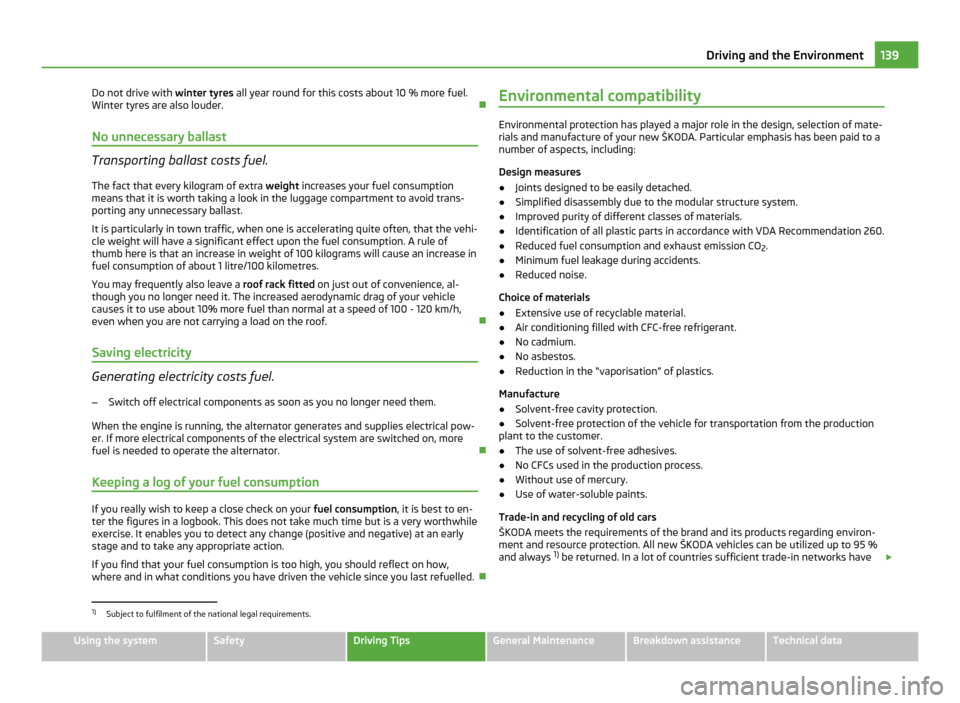
Do not drive with winter tyres all year round for this costs about 10 % more fuel.
Winter tyres are also louder.
No unnecessary ballast Transporting ballast costs fuel.
The fact that every kilogram of extra weight increases your fuel consumption
means that it is worth taking a look in the luggage compartment to avoid trans-
porting any unnecessary ballast.
It is particularly in town traffic, when one is accelerating quite often, that the vehi-
cle weight will have a significant effect upon the fuel consumption. A rule of
thumb here is that an increase in weight of 100 kilograms will cause an increase in
fuel consumption of about 1 litre/100 kilometres.
You may frequently also leave a roof rack fitted
on just out of convenience, al-
though you no longer need it. The increased aerodynamic drag of your vehicle
causes it to use about 10% more fuel than normal at a speed of 100 - 120 km/h,
even when you are not carrying a load on the roof.
Saving electricity Generating electricity costs fuel.
– Switch off electrical components as soon as you no longer need them.
When the engine is running, the alternator generates and supplies electrical pow-
er. If more electrical components of the electrical system are switched on, more
fuel is needed to operate the alternator.
Keeping a log of your fuel consumption If you really wish to keep a close check on your
fuel consumption, it is best to en-
ter the figures in a logbook. This does not take much time but is a very worthwhile
exercise. It enables you to detect any change (positive and negative) at an early
stage and to take any appropriate action.
If you find that your fuel consumption is too high, you should reflect on how,
where and in what conditions you have driven the vehicle since you last refuelled. Environmental compatibility Environmental protection has played a major role in the design, selection of mate-
rials and manufacture of your new
ŠKODA. Particular emphasis has been paid to a
number of aspects, including:
Design measures
● Joints designed to be easily detached.
● Simplified disassembly due to the modular structure system.
● Improved purity of different classes of materials.
● Identification of all plastic parts in accordance with VDA Recommendation 260.
● Reduced fuel consumption and exhaust emission CO
2.
● Minimum fuel leakage during accidents.
● Reduced noise.
Choice of materials
● Extensive use of recyclable material.
● Air conditioning filled with CFC-free refrigerant.
● No cadmium.
● No asbestos.
● Reduction in the
“vaporisation” of plastics.
Manufacture
● Solvent-free cavity protection.
● Solvent-free protection of the vehicle for transportation from the production
plant to the customer.
● The use of solvent-free adhesives.
● No CFCs used in the production process.
● Without use of mercury.
● Use of water-soluble paints.
Trade-in and recycling of old cars
ŠKODA meets the requirements of the brand and its products regarding environ-
ment and resource protection. All new ŠKODA vehicles can be utilized up to 95
%
and always 1)
be returned. In a lot of countries sufficient trade-in networks have £1)
Subject to fulfilment of the national legal requirements. 139
Driving and the Environment Using the system Safety Driving Tips General Maintenance Breakdown assistance Technical data
Page 142 of 220
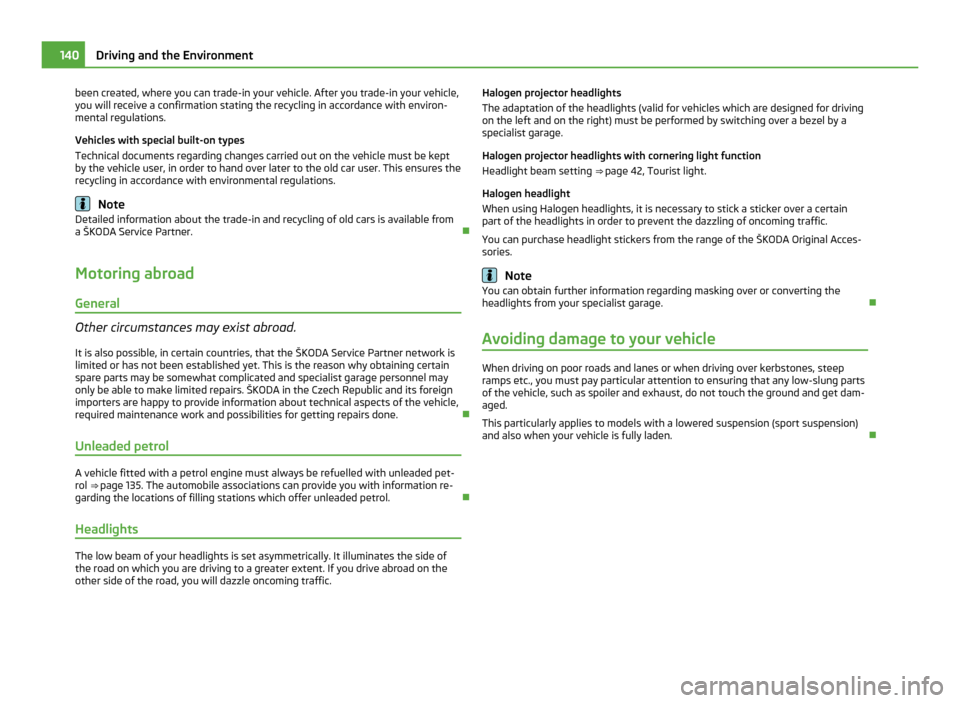
been created, where you can trade-in your vehicle. After you trade-in your vehicle,
you will receive a confirmation stating the recycling in accordance with environ-
mental regulations.
Vehicles with special built-on types
Technical documents regarding changes carried out on the vehicle must be kept
by the vehicle user, in order to hand over later to the old car user. This ensures the
recycling in accordance with environmental regulations.
Note
Detailed information about the trade-in and recycling of old cars is available from
a ŠKODA Service Partner.
Motoring abroad General Other circumstances may exist abroad.
It is also possible, in certain countries, that the ŠKODA
Service Partner network is
limited or has not been established yet. This is the reason why obtaining certain
spare parts may be somewhat complicated and specialist garage personnel may
only be able to make limited repairs. ŠKODA in the Czech Republic and its foreign
importers are happy to provide information about technical aspects of the vehicle,
required maintenance work and possibilities for getting repairs done.
Unleaded petrol A vehicle fitted with a petrol engine must always be refuelled with unleaded pet-
rol
⇒ page 135. The automobile associations can provide you with information re-
garding the locations of filling stations which offer unleaded petrol.
Headlights The low beam of your headlights is set asymmetrically. It illuminates the side of
the road on which you are driving to a greater extent. If you drive abroad on the
other side of the road, you will dazzle oncoming traffic. Halogen projector headlights
The adaptation of the headlights (valid for vehicles which are designed for driving
on the left and on the right) must be performed by switching over a bezel by a
specialist garage.
Halogen projector headlights with cornering light function
Headlight beam setting
⇒ page 42, Tourist light.
Halogen headlight
When using Halogen headlights, it is necessary to stick a sticker over a certain
part of the headlights in order to prevent the dazzling of oncoming traffic.
You can purchase headlight stickers from the range of the
ŠKODA Original Acces-
sories. Note
You can obtain further information regarding masking over or converting the
headlights from your specialist garage.
Avoiding damage to your vehicle When driving on poor roads and lanes or when driving over kerbstones, steep
ramps etc., you must pay particular attention to ensuring that any low-slung parts
of the vehicle, such as spoiler and exhaust, do not touch the ground and get dam-
aged.
This particularly applies to models with a lowered suspension (sport suspension)
and also when your vehicle is fully laden.
140
Driving and the Environment
Page 143 of 220
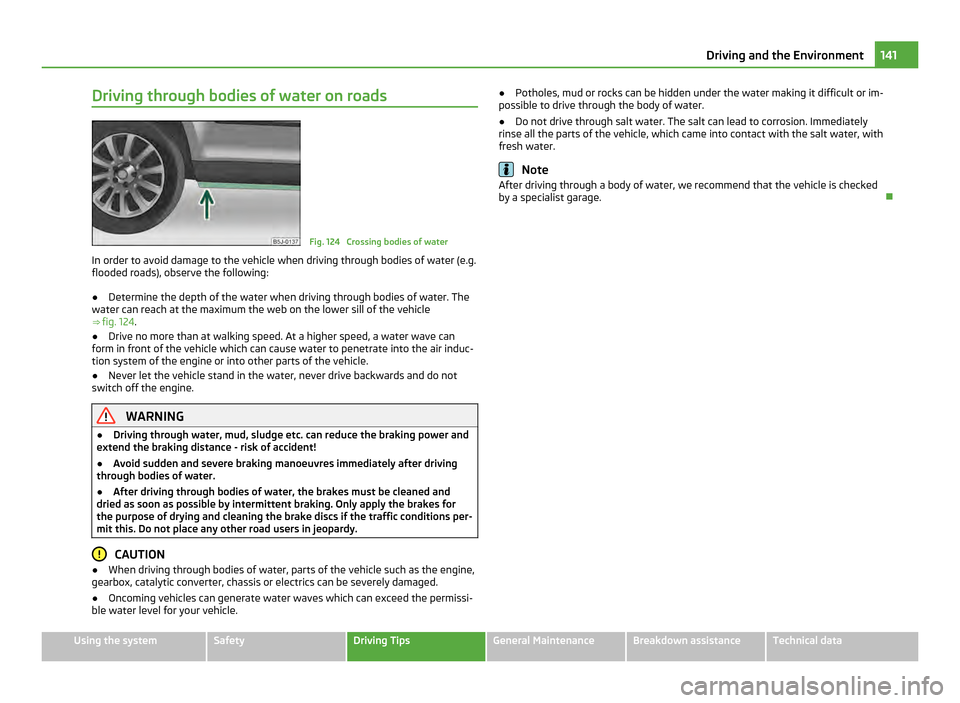
Driving through bodies of water on roads
Fig. 124 Crossing bodies of water
In order to avoid damage to the vehicle when driving through bodies of water (e.g.
flooded roads), observe the following:
● Determine the depth of the water when driving through bodies of water. The
water can reach at the maximum the web on the lower sill of the vehicle
⇒ fig. 124.
● Drive no more than at walking speed. At a higher speed, a water wave can
form in front of the vehicle which can cause water to penetrate into the air induc-
tion system of the engine or into other parts of the vehicle.
● Never let the vehicle stand in the water, never drive backwards and do not
switch off the engine. WARNING
● Driving through water, mud, sludge etc. can reduce the braking power and
extend the braking distance - risk of accident!
● Avoid sudden and severe braking manoeuvres immediately after driving
through bodies of water.
● After driving through bodies of water, the brakes must be cleaned and
dried as soon as possible by intermittent braking. Only apply the brakes for
the purpose of drying and cleaning the brake discs if the traffic conditions per-
mit this. Do not place any other road users in jeopardy. CAUTION
● When driving through bodies of water, parts of the vehicle such as the engine,
gearbox, catalytic converter, chassis or electrics can be severely damaged.
● Oncoming vehicles can generate water waves which can exceed the permissi-
ble water level for your vehicle. ●
Potholes, mud or rocks can be hidden under the water making it difficult or im-
possible to drive through the body of water.
● Do not drive through salt water. The salt can lead to corrosion. Immediately
rinse all the parts of the vehicle, which came into contact with the salt water, with
fresh water. Note
After driving through a body of water, we recommend that the vehicle is checked
by a specialist garage. 141
Driving and the Environment Using the system Safety Driving Tips General Maintenance Breakdown assistance Technical data
Page 144 of 220
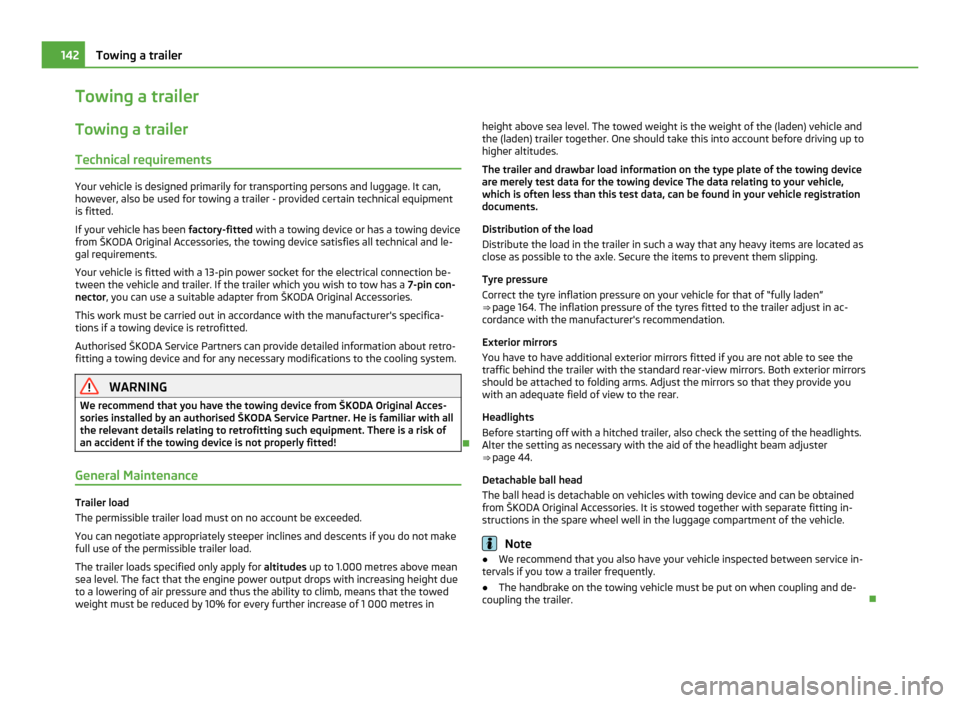
Towing a trailer
Towing a trailer
Technical requirements Your vehicle is designed primarily for transporting persons and luggage. It can,
however, also be used for towing a trailer - provided certain technical equipment
is fitted.
If your vehicle has been
factory-fitted with a towing device or has a towing device
from ŠKODA Original Accessories, the towing device satisfies all technical and le-
gal requirements.
Your vehicle is fitted with a 13-pin power socket for the electrical connection be-
tween the vehicle and trailer. If the trailer which you wish to tow has a 7-pin con-
nector , you can use a suitable adapter from
ŠKODA Original Accessories.
This work must be carried out in accordance with the manufacturer's specifica-
tions if a towing device is retrofitted.
Authorised ŠKODA Service Partners can provide detailed information about retro-
fitting a towing device and for any necessary modifications to the cooling system. WARNING
We recommend that you have the towing device from ŠKODA Original Acces-
sories installed by an authorised ŠKODA Service Partner. He is familiar with all
the relevant details relating to retrofitting such equipment. There is a risk of
an accident if the towing device is not properly fitted!
General Maintenance Trailer load
The permissible trailer load must on no account be exceeded.
You can negotiate appropriately steeper inclines and descents if you do not make
full use of the permissible trailer load.
The trailer loads specified only apply for
altitudes up to 1.000 metres above mean
sea level. The fact that the engine power output drops with increasing height due
to a lowering of air pressure and thus the ability to climb, means that the towed
weight must be reduced by 10% for every further increase of 1 000 metres in height above sea level. The towed weight is the weight of the (laden) vehicle and
the (laden) trailer together. One should take this into account before driving up to
higher altitudes.
The trailer and drawbar load information on the type plate of the towing device
are merely test data for the towing device The data relating to your vehicle,
which is often less than this test data, can be found in your vehicle registration
documents.
Distribution of the load
Distribute the load in the trailer in such a way that any heavy items are located as
close as possible to the axle. Secure the items to prevent them slipping.
Tyre pressure
Correct the tyre inflation pressure on your vehicle for that of
“fully laden
”
⇒ page 164. The inflation pressure of the tyres fitted to the trailer adjust in ac-
cordance with the manufacturer's recommendation.
Exterior mirrors
You have to have additional exterior mirrors fitted if you are not able to see the
traffic behind the trailer with the standard rear-view mirrors. Both exterior mirrors
should be attached to folding arms. Adjust the mirrors so that they provide you
with an adequate field of view to the rear.
Headlights
Before starting off with a hitched trailer, also check the setting of the headlights.
Alter the setting as necessary with the aid of the headlight beam adjuster
⇒ page 44.
Detachable ball head
The ball head is detachable on vehicles with towing device and can be obtained
from ŠKODA Original Accessories. It is stowed together with separate fitting in-
structions in the spare wheel well in the luggage compartment of the vehicle. Note
● We recommend that you also have your vehicle inspected between service in-
tervals if you tow a trailer frequently.
● The handbrake on the towing vehicle must be put on when coupling and de-
coupling the trailer. 142
Towing a trailer
Page 145 of 220
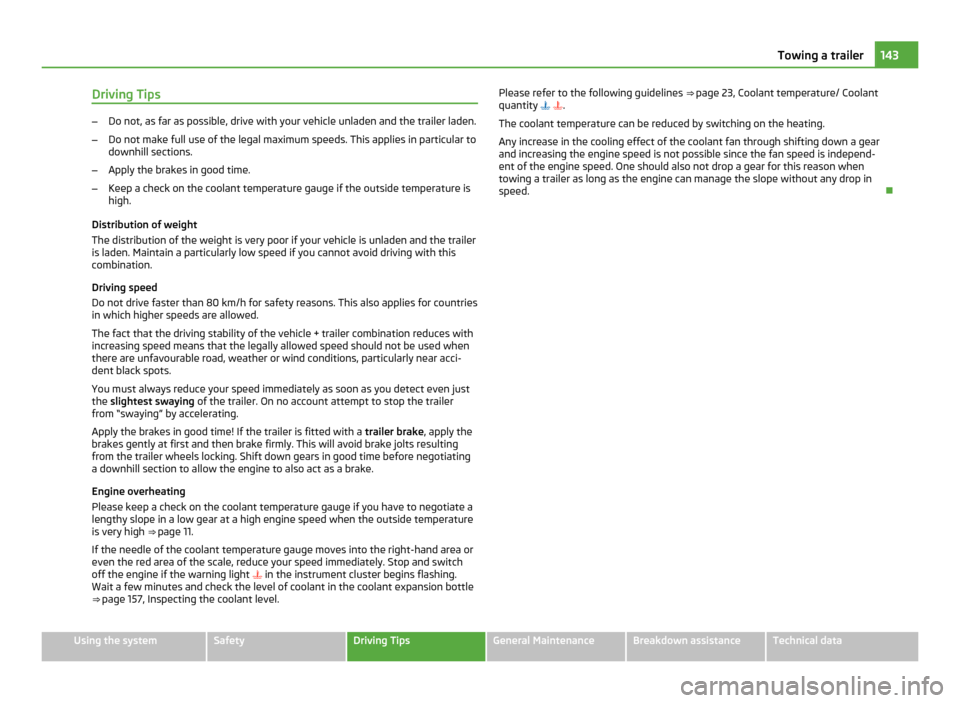
Driving Tips
–
Do not, as far as possible, drive with your vehicle unladen and the trailer laden.
– Do not make full use of the legal maximum speeds. This applies in particular to
downhill sections.
– Apply the brakes in good time.
– Keep a check on the coolant temperature gauge if the outside temperature is
high.
Distribution of weight
The distribution of the weight is very poor if your vehicle is unladen and the trailer
is laden. Maintain a particularly low speed if you cannot avoid driving with this
combination.
Driving speed
Do not drive faster than 80 km/h for safety reasons. This also applies for countries
in which higher speeds are allowed.
The fact that the driving stability of the vehicle + trailer combination reduces with
increasing speed means that the legally allowed speed should not be used when
there are unfavourable road, weather or wind conditions, particularly near acci-
dent black spots.
You must always reduce your speed immediately as soon as you detect even just
the slightest swaying
of the trailer. On no account attempt to stop the trailer
from “swaying” by accelerating.
Apply the brakes in good time! If the trailer is fitted with a trailer brake, apply the
brakes gently at first and then brake firmly. This will avoid brake jolts resulting
from the trailer wheels locking. Shift down gears in good time before negotiating
a downhill section to allow the engine to also act as a brake.
Engine overheating
Please keep a check on the coolant temperature gauge if you have to negotiate a
lengthy slope in a low gear at a high engine speed when the outside temperature
is very high ⇒ page 11.
If the needle of the coolant temperature gauge moves into the right-hand area or
even the red area of the scale, reduce your speed immediately. Stop and switch
off the engine if the warning light in the instrument cluster begins flashing.
Wait a few minutes and check the level of coolant in the coolant expansion bottle
⇒ page 157, Inspecting the coolant level. Please refer to the following guidelines
⇒ page 23
, Coolant temperature/ Coolant
quantity .
The coolant temperature can be reduced by switching on the heating.
Any increase in the cooling effect of the coolant fan through shifting down a gear
and increasing the engine speed is not possible since the fan speed is independ-
ent of the engine speed. One should also not drop a gear for this reason when
towing a trailer as long as the engine can manage the slope without any drop in
speed. 143
Towing a trailer Using the system Safety Driving Tips General Maintenance Breakdown assistance Technical data
Page 146 of 220
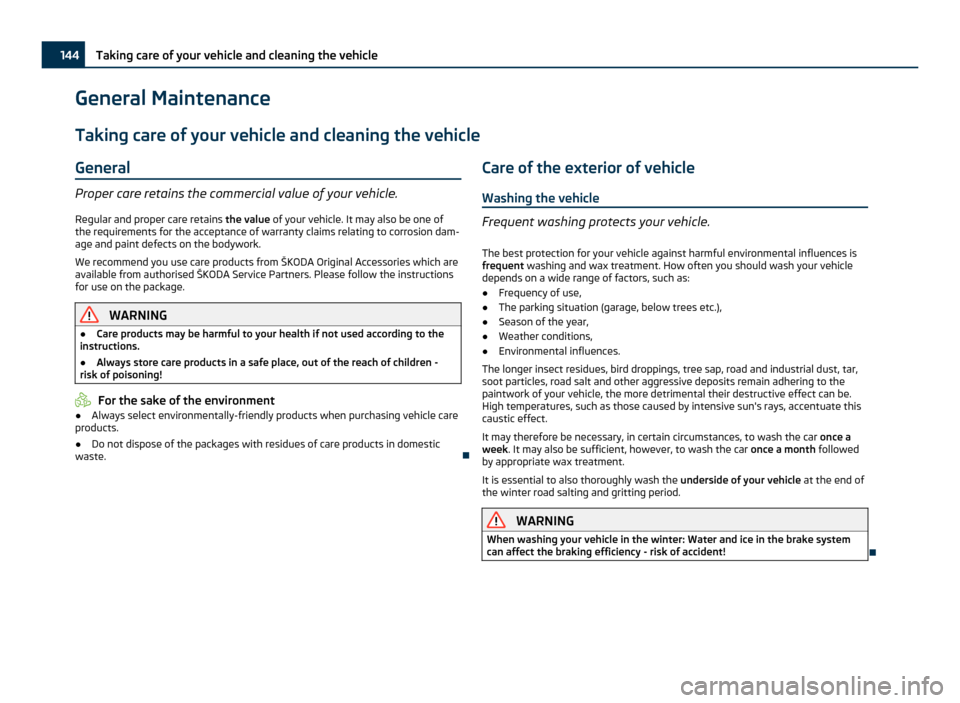
General Maintenance
Taking care of your vehicle and cleaning the vehicle
General Proper care retains the commercial value of your vehicle.
Regular and proper care retains the value of your vehicle. It may also be one of
the requirements for the acceptance of warranty claims relating to corrosion dam-
age and paint defects on the bodywork.
We recommend you use care products from ŠKODA Original Accessories which are
available from authorised ŠKODA Service Partners. Please follow the instructions
for use on the package. WARNING
● Care products may be harmful to your health if not used according to the
instructions.
● Always store care products in a safe place, out of the reach of children -
risk of poisoning! For the sake of the environment
● Always select environmentally-friendly products when purchasing vehicle care
products.
● Do not dispose of the packages with residues of care products in domestic
waste. Care of the exterior of vehicle
Washing the vehicle Frequent washing protects your vehicle.
The best protection for your vehicle against harmful environmental influences is
frequent washing and wax treatment. How often you should wash your vehicle
depends on a wide range of factors, such as:
● Frequency of use,
● The parking situation (garage, below trees etc.),
● Season of the year,
● Weather conditions,
● Environmental influences.
The longer insect residues, bird droppings, tree sap, road and industrial dust, tar,
soot particles, road salt and other aggressive deposits remain adhering to the
paintwork of your vehicle, the more detrimental their destructive effect can be.
High temperatures, such as those caused by intensive sun's rays, accentuate this
caustic effect.
It may therefore be necessary, in certain circumstances, to wash the car once a
week. It may also be sufficient, however, to wash the car once a month followed
by appropriate wax treatment.
It is essential to also thoroughly wash the underside of your vehicle at the end of
the winter road salting and gritting period. WARNING
When washing your vehicle in the winter: Water and ice in the brake system
can affect the braking efficiency - risk of accident! 144
Taking care of your vehicle and cleaning the vehicle
Page 147 of 220
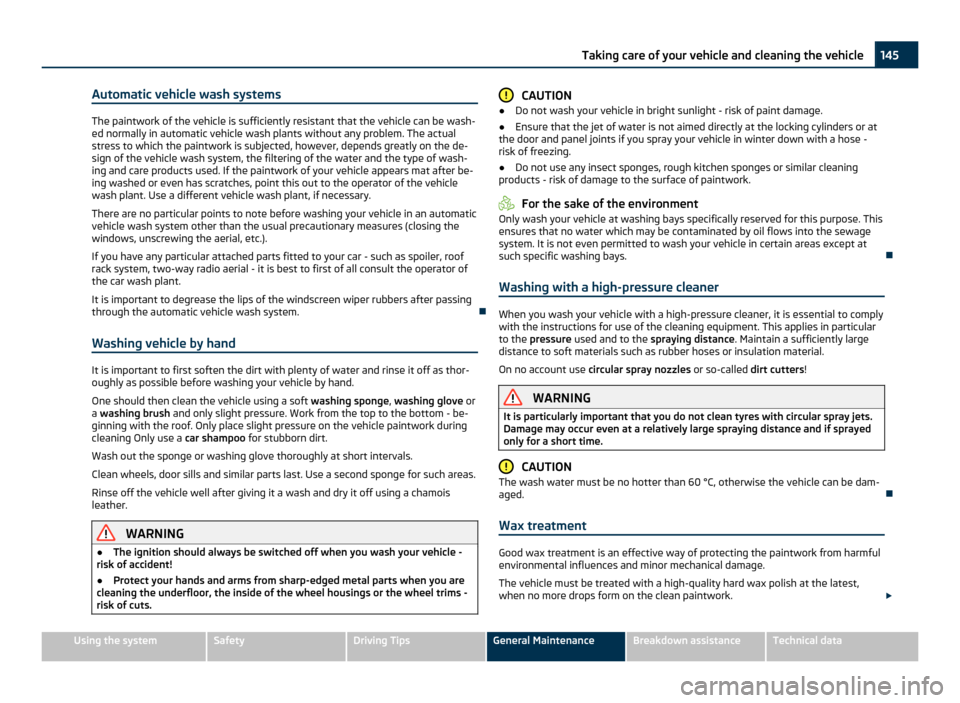
Automatic vehicle wash systems
The paintwork of the vehicle is sufficiently resistant that the vehicle can be wash-
ed normally in automatic vehicle wash plants without any problem. The actual
stress to which the paintwork is subjected, however, depends greatly on the de-
sign of the vehicle wash system, the filtering of the water and the type of wash-
ing and care products used. If the paintwork of your vehicle appears mat after be-
ing washed or even has scratches, point this out to the operator of the vehicle
wash plant. Use a different vehicle wash plant, if necessary.
There are no particular points to note before washing your vehicle in an automatic
vehicle wash system other than the usual precautionary measures (closing the
windows, unscrewing the aerial, etc.).
If you have any particular attached parts fitted to your car - such as spoiler, roof
rack system, two-way radio aerial - it is best to first of all consult the operator of
the car wash plant.
It is important to degrease the lips of the windscreen wiper rubbers after passing
through the automatic vehicle wash system.
Washing vehicle by hand It is important to first soften the dirt with plenty of water and rinse it off as thor-
oughly as possible before washing your vehicle by hand.
One should then clean the vehicle using a soft
washing sponge, washing glove or
a washing brush and only slight pressure. Work from the top to the bottom - be-
ginning with the roof. Only place slight pressure on the vehicle paintwork during
cleaning Only use a car shampoo for stubborn dirt.
Wash out the sponge or washing glove thoroughly at short intervals.
Clean wheels, door sills and similar parts last. Use a second sponge for such areas.
Rinse off the vehicle well after giving it a wash and dry it off using a chamois
leather. WARNING
● The ignition should always be switched off when you wash your vehicle -
risk of accident!
● Protect your hands and arms from sharp-edged metal parts when you are
cleaning the underfloor, the inside of the wheel housings or the wheel trims -
risk of cuts. CAUTION
● Do not wash your vehicle in bright sunlight - risk of paint damage.
● Ensure that the jet of water is not aimed directly at the locking cylinders or at
the door and panel joints if you spray your vehicle in winter down with a hose -
risk of freezing.
● Do not use any insect sponges, rough kitchen sponges or similar cleaning
products - risk of damage to the surface of paintwork. For the sake of the environment
Only wash your vehicle at washing bays specifically reserved for this purpose. This
ensures that no water which may be contaminated by oil flows into the sewage
system. It is not even permitted to wash your vehicle in certain areas except at
such specific washing bays.
Washing with a high-pressure cleaner When you wash your vehicle with a high-pressure cleaner, it is essential to comply
with the instructions for use of the cleaning equipment. This applies in particular
to the pressure
used and to the spraying distance. Maintain a sufficiently large
distance to soft materials such as rubber hoses or insulation material.
On no account use circular spray nozzles or so-called dirt cutters! WARNING
It is particularly important that you do not clean tyres with circular spray jets.
Damage may occur even at a relatively large spraying distance and if sprayed
only for a short time. CAUTION
The wash water must be no hotter than 60 °C, otherwise the vehicle can be dam-
aged.
Wax treatment Good wax treatment is an effective way of protecting the paintwork from harmful
environmental influences and minor mechanical damage.
The vehicle must be treated with a high-quality hard wax polish at the latest,
when no more drops form on the clean paintwork.
£ 145
Taking care of your vehicle and cleaning the vehicle Using the system Safety Driving Tips General Maintenance Breakdown assistance Technical data
Page 148 of 220
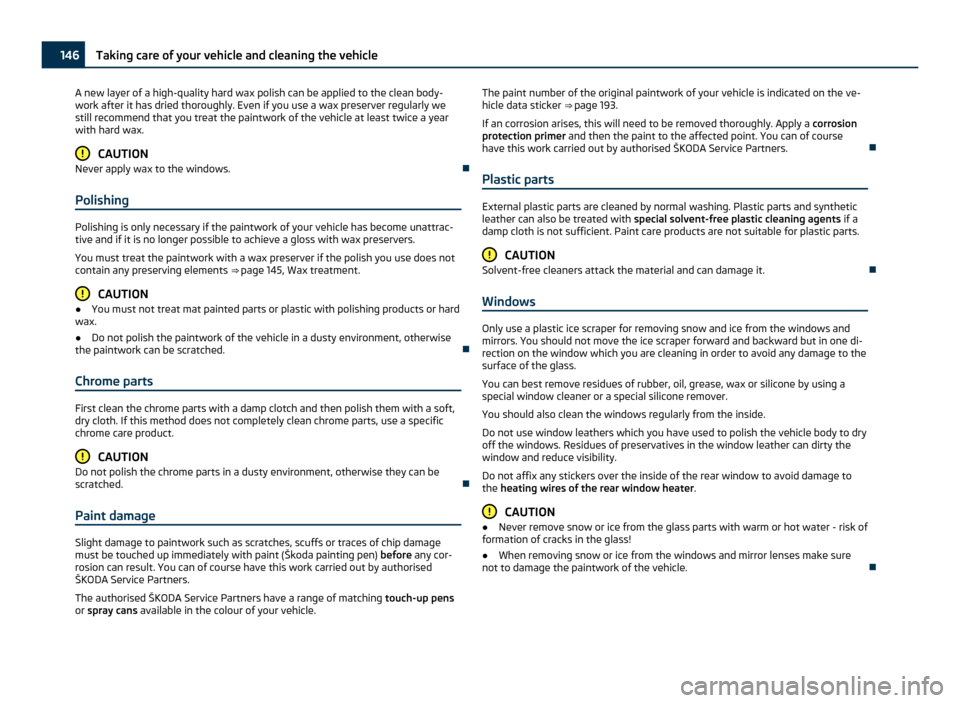
A new layer of a high-quality hard wax polish can be applied to the clean body-
work after it has dried thoroughly. Even if you use a wax preserver regularly we
still recommend that you treat the paintwork of the vehicle at least twice a year
with hard wax.
CAUTION
Never apply wax to the windows.
Polishing Polishing is only necessary if the paintwork of your vehicle has become unattrac-
tive and if it is no longer possible to achieve a gloss with wax preservers.
You must treat the paintwork with a wax preserver if the polish you use does not
contain any preserving elements
⇒ page 145, Wax treatment
.CAUTION
● You must not treat mat painted parts or plastic with polishing products or hard
wax.
● Do not polish the paintwork of the vehicle in a dusty environment, otherwise
the paintwork can be scratched.
Chrome parts First clean the chrome parts with a damp clotch and then polish them with a soft,
dry cloth. If this method does not completely clean chrome parts, use a specific
chrome care product.
CAUTION
Do not polish the chrome parts in a dusty environment, otherwise they can be
scratched.
Paint damage Slight damage to paintwork such as scratches, scuffs or traces of chip damage
must be touched up immediately with paint (Škoda painting pen)
before any cor-
rosion can result. You can of course have this work carried out by authorised
ŠKODA Service Partners.
The authorised ŠKODA Service Partners have a range of matching touch-up pens
or
spray cans available in the colour of your vehicle. The paint number of the original paintwork of your vehicle is indicated on the ve-
hicle data sticker
⇒ page 193.
If an corrosion arises, this will need to be removed thoroughly. Apply a corrosion
protection primer
and then the paint to the affected point. You can of course
have this work carried out by authorised ŠKODA Service Partners.
Plastic parts External plastic parts are cleaned by normal washing. Plastic parts and synthetic
leather can also be treated with
special solvent-free plastic cleaning agents if a
damp cloth is not sufficient. Paint care products are not suitable for plastic parts. CAUTION
Solvent-free cleaners attack the material and can damage it.
Windows Only use a plastic ice scraper for removing snow and ice from the windows and
mirrors. You should not move the ice scraper forward and backward but in one di-
rection on the window which you are cleaning in order to avoid any damage to the
surface of the glass.
You can best remove residues of rubber, oil, grease, wax or silicone by using a
special window cleaner or a special silicone remover.
You should also clean the windows regularly from the inside.
Do not use window leathers which you have used to polish the vehicle body to dry
off the windows. Residues of preservatives in the window leather can dirty the
window and reduce visibility.
Do not affix any stickers over the inside of the rear window to avoid damage to
the
heating wires of the rear window heater . CAUTION
● Never remove snow or ice from the glass parts with warm or hot water - risk of
formation of cracks in the glass!
● When removing snow or ice from the windows and mirror lenses make sure
not to damage the paintwork of the vehicle. 146
Taking care of your vehicle and cleaning the vehicle
Page 149 of 220

The headlight lenses
Please do not use any aggressive cleaning or chemical solvent products for clean-
ing the front headlights - risk of damage to the plastic lenses.
Please use soap
and clean warm water. CAUTION
Never wipe the headlights dry and do not use any sharp objects for cleaning the
plastic lenses, this may result in damage to the protective paintwork and conse-
quently in formation of cracks on the headlight lenses, e.g. through effect of
chemical products.
Door and window seals The rubber seals on the doors, boot lid, bonnet and windows remain supple and
last longer if you treat them regularly with a rubber care product (e.
g. with a spray
with silicone-free oil). You also avoid premature wear of the seals and prevent
leakages in this way. It is also easier to open the doors. Rubber seals which are
well cared for also do not stick together in cold winter weather.
Locking cylinder Use specific products for de-icing locking cylinders.
Note
When washing your vehicle, ensure that as little water as possible gets into the
locking cylinders.
Wheels Steel wheels
You should also thoroughly wash the wheels and wheel trims when giving your
vehicle its regular wash. This prevents any brake dust, dirt and road salt from
sticking to the wheel hubs. You can remove stubborn brake abrasion adhering to
the wheels with an industrial cleaner. Touch up any damage to the paintwork on
the wheels before rust is able to form. Light alloy wheels
Regular care of light alloy wheels is necessary in order to retain their decorative
appearance over long periods. It is particularly important to remove regularly any
road salt and brake abrasion from light alloy wheels, otherwise the light metal will
suffer. Wash thoroughly and then treat the wheels with a protective product for
light alloy wheels which does not contain any acidic components. We recommend
to apply a hard wax layer onto the wheel hubs every three months. You must not
use any products which cause abrasion when treating the wheel hubs. Any dam-
age to the paint layer on the wheel hubs must be touched up immediately.
WARNING
One should remember when cleaning the wheels that moisture, ice and road
salt may adversely affect braking efficiency - risk of an accident! Note
Severe layers of dirt on the wheels can also result in wheel imbalance. This may
show itself in the form of a wheel vibration which is transmitted to the steering
wheel which, in certain circumstances, can cause premature wear of the steering.
This means it is necessary to remove the dirt.
Underbody protection The underside of your vehicle is protected for life against chemical and mechanical
influences.
One cannot, however, completely rule out damage to the
protective layer when
driving so we recommend that you inspect the protective layer on the underside
of your vehicle and on the chassis at certain intervals - this is best done at the be-
ginning and end of the winter - and to touch up any damaged areas.
The authorised
ŠKODA Service Partners have suitable spray products available as
well as the necessary equipment and are familiar with the instructions for use.
Therefore, we recommend you have such touch-up work or additional corrosion
protection measures carried out by an authorised ŠKODA Service Partner. WARNING
Never use additional underbody protection or corrosion-protection agents for
the exhaust pipes, catalytic converters, diesel particle filter or heat shields.
When the engine reaches its operating temperature, these substances might
ignite - risk of fire! 147
Taking care of your vehicle and cleaning the vehicle Using the system Safety Driving Tips General Maintenance Breakdown assistance Technical data
Page 150 of 220
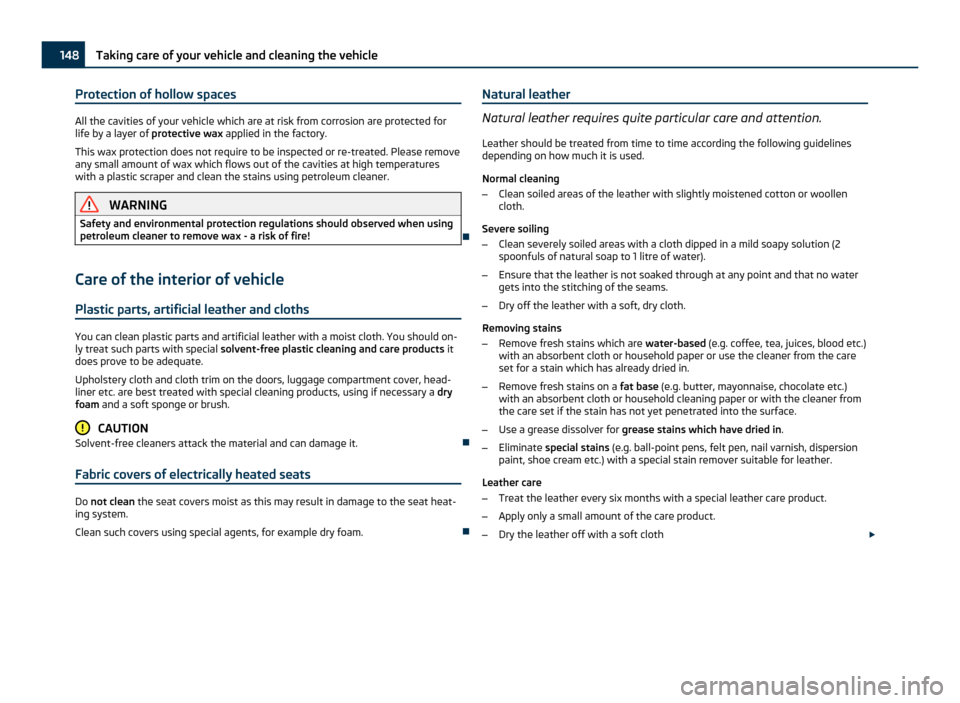
Protection of hollow spaces
All the cavities of your vehicle which are at risk from corrosion are protected for
life by a layer of
protective wax applied in the factory.
This wax protection does not require to be inspected or re-treated. Please remove
any small amount of wax which flows out of the cavities at high temperatures
with a plastic scraper and clean the stains using petroleum cleaner. WARNING
Safety and environmental protection regulations should observed when using
petroleum cleaner to remove wax - a risk of fire!
Care of the interior of vehicle Plastic parts, artificial leather and cloths You can clean plastic parts and artificial leather with a moist cloth. You should on-
ly treat such parts with special
solvent-free plastic cleaning and care products it
does prove to be adequate.
Upholstery cloth and cloth trim on the doors, luggage compartment cover, head-
liner etc. are best treated with special cleaning products, using if necessary a dry
foam and a soft sponge or brush. CAUTION
Solvent-free cleaners attack the material and can damage it.
Fabric covers of electrically heated seats Do not clean
the seat covers moist as this may result in damage to the seat heat-
ing system.
Clean such covers using special agents, for example dry foam. Natural leather Natural leather requires quite particular care and attention.
Leather should be treated from time to time according the following guidelines
depending on how much it is used.
Normal cleaning
– Clean soiled areas of the leather with slightly moistened cotton or woollen
cloth.
Severe soiling
– Clean severely soiled areas with a cloth dipped in a mild soapy solution (2
spoonfuls of natural soap to 1 litre of water).
– Ensure that the leather is not soaked through at any point and that no water
gets into the stitching of the seams.
– Dry off the leather with a soft, dry cloth.
Removing stains
– Remove fresh stains which are water-based (e.g. coffee, tea, juices, blood etc.)
with an absorbent cloth or household paper or use the cleaner from the care
set for a stain which has already dried in.
– Remove fresh stains on a fat base (e.g. butter, mayonnaise, chocolate etc.)
with an absorbent cloth or household cleaning paper or with the cleaner from
the care set if the stain has not yet penetrated into the surface.
– Use a grease dissolver for grease stains which have dried in .
– Eliminate special stains (e.g. ball-point pens, felt pen, nail varnish, dispersion
paint, shoe cream etc.) with a special stain remover suitable for leather.
Leather care
– Treat the leather every six months with a special leather care product.
– Apply only a small amount of the care product.
– Dry the leather off with a soft cloth £148
Taking care of your vehicle and cleaning the vehicle